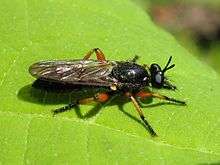Laphria (fly)
Laphria, the bee-like robber flies, is a genus described by Johann Wilhelm Meigen in 1803, belonging to the family Asilidae, subfamily Laphriinae. This genus has a Holarctic distribution, occurring in Europe, Asia, and North America. They generally prey on insects of various species, including other robber flies, bees, wasps and beetles. Their characteristic mouth allow the species of Laphria to penetrate their sclerotized proboscis in between the elytra of preyed beetles. All the preys are dissolved by special enzymes injected in their bodies, which are then sucked out by the predator.
| Laphria | |
|---|---|
 | |
| Laphria sadales | |
| Scientific classification | |
| Kingdom: | Animalia |
| Phylum: | Arthropoda |
| Class: | Insecta |
| Order: | Diptera |
| Family: | Asilidae |
| Subfamily: | Laphriinae |
| Genus: | Laphria Meigen, 1803 |
The adults average sizes reach 15–25 mm (0.59–0.98 in). These huge robber flies are quite hairy and their body is usually black, while some have bee-mimicking abdomens with black and yellow stripes (See Laphria thoracica). They can be encountered from July through September.
Species
Select species include:[1][2][3][4]
- Laphria affinis Macquart, 1855
- Laphria aktis Mcatee, 1919
- Laphria altitudinum Bromley, 1924
- Laphria apila (Bromley, 1951)
- Laphria canis Williston, 1883
- Laphria ephippium (Fabricius, 1781)
- Laphria fernaldi (Back, 1904)
- Laphria flava (Linnaeus, 1761)
- Laphria flavescens Macquart, 1838
- Laphria flavicollis Say, 1824
- Laphria ithypyga Mcatee, 1919
- Laphria ivorina Oldroyd, 1968
- Laphria kistjakovskiji Paramonov, 1929
- Laphria sadales Walker, 1849
- Laphria saffrana Fabricius, 1805
- Laphria sapporensis Matsumura, 1911
- Laphria thoracica Fabricius, 1805
- Laphria tibialis Meigen, 1820
- Laphria venezuelensis Macquart, 1846
- Laphria ventralis Williston, 1885
- Laphria violacea Macquart, 1846
- Laphria vulpina Meigen, 1820
- Laphria xanthothrix Hermann, 1914
- Laphria yamatonis Matsumura, 1916
- Laphria ephippium

References
- "Laphria Report". Integrated Taxonomic Information System. Retrieved 2018-04-12.
- "Browse Laphria". Catalogue of Life. Retrieved 2018-04-12.
- "Laphria". GBIF. Retrieved 2018-04-12.
- "Laphria Genus Information". BugGuide.net. Retrieved 2018-04-12.
- W. L. Mcatee - Key to the Nearctic Species of the genus Laphria (Diptera, Asilidae) - Kb.osu.edu
- Stephen W. Bullington, Ph.D. - Users.usachoice
- Herschel Raney - Laphria of Arkansas
External links
- Laphira at Entomology Museum Alberta